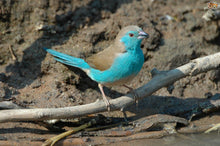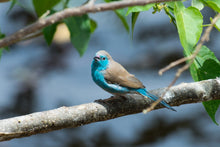The Blue Waxbill (Uraeginthus angolensis), also called Blue-breasted Cordon-bleu, is a common species of estrildid finch found in Southern Africa.
Disposition
Peaceful, quiet, defensive of their nest.
Physical descriptions
In general, the cordon bleu has brown feathering above, blue feathering on the face, breast, flanks, and tail, and buff under parts; the beak is a deep pink. Blue-breasted: very similar to the red-cheeked cordon bleu, except the cock does not have red cheek patches. Also, the blue coloring tends to be slightly more extensive in the areas of the breast and flanks. Hens of all three subspecies look nearly identical to each other, all being more dull and having less extensive blue feathering on their bodies than the cocks have. Cocks are more intensely colored and tend to have more blue coloring.
Breeding season
In the wild, cordon bleus pair off and build nests (often among thorns and close to wasp nests) after the rainy season ends (usually January to June) when termites and green seeds are plentiful. These birds may be stimulated to breed at nearly any time in captivity, as long as the ambient temperature is kept warm, the enclosure is kept dry, and plenty of live food is provided. Spring-Summer breeding is recommended.
Diet
Paradise Earth Premium Finch Blend, Insect Blend and greens.






